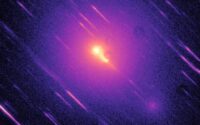Three months after Chinese spy balloon, DoD lagging on UFO office efforts
WASHINGTON – Nearly three months after the Defense Department spent at least $1.6 million to shoot down three unidentified objects later believed to have been harmless, the Senate Intelligence Committee wants to know why the Pentagon hasn’t made more progress strengthening its UFO analysis office, The Post exclusively learned.
“There are objects in our airspace and near military facilities that we cannot identify. What’s worse, our government spent too many years ignoring or downplaying the threat,” the committee’s top Republican Sen. Marco Rubio (R-Fla.) exclusively told the Post on Friday.
“Thankfully, that is beginning to change, but as we saw earlier this year, the defense and intelligence communities are still struggling.”
Congress in December ordered the Pentagon to strengthen its relatively new “All-Domain Anomaly Resolution Office” (AARO) that studies unidentified aerial phenomena — military jargon for UFOs — as part of the 2023 National Defense Authorization Act, which lays out its policy and spending priorities for the year.
In it, lawmakers called for the office to become “the nation’s clearinghouse and analytic center of gravity” for UFOs so it can “inform both the intelligence community and US Department of Defense leaders about UAP and to avoid strategic intelligence surprise,” Rubio and committee chairman Sen. Mark Warner (D-Va.) wrote in a letter Thursday to Defense Secretary Lloyd Austin and Director of National Intelligence Avril Haines.

“Nearly four months after enactment of the FY23 NDAA, we are concerned not to have seen more tangible evidence of the implementation of the [UFO office parameters prescribed],” they said, calling the Pentagon “slow” to enact the law’s AARO guidance.
For example, the 2023 NDAA promoted the UFO office’s director to report directly to the principal deputy director of national intelligence and deputy secretary of defense.
But that still hasn’t happened yet, the committee said.

“Despite assurances that there is a proposed plan to implement this change in reporting in circulation, we have yet to see any final guidance issued,” the committee told Austin.
“We request that you provide us an update on the proposed plan including the timeline for issuance of the final guidance.
It also specified that the US director of national intelligence would appoint a deputy director for the AARO from the intelligence community – but none have been identified.

“The deputy director of AARO is intended to be the focal point for [intelligence community] integration and to be fully empowered by the [Office of the Director of National Inteligence] to convene the IC on the UAP issue,” the committee wrote, asking for a “timeline for appointing a deputy director.”
While the NDAA became law before the military identified — and later shot down — a Chinese spy balloon floating through US air space in late January, lawmakers said the incident was a “wakeup call” for the defense and intelligence communities.
But when President Joe Biden then ordered the military to shoot down three more UFOs less than two weeks later without knowing if they posed a malicious threat, the need for a fully staffed office dedicated to identifying the unidentified became more clear, Rubio said.
“It’s important to remember in February, the Biden administration shot down three UAPs in Alaska, Canada and over Lake Huron,” Rubio told The Post.
“Senior Pentagon leaders said publicly that two of the UAP were almost certainly not balloons, but Congress has not been provided the rationale or sensor data to support this unprecedented action.”
In a spate of three days, the military shot four $400,000 missiles to take down the three UFOs that were later believed to have been hobby or weather balloons unaffiliated with a foreign government, something lawmakers say could have been avoided had more information been known.
“In this instance, we shot down multiple UAP, and it’s not clear to this day we know with confidence what they were,” Rubio said.
“We stood up the AARO office to address just such an instance; to rapidly aggregate and analyze the data and apply the scientific process.”
To date, much of the Pentagon’s difficulty identifying UFOs has been attributed to a lack of data, according to a 2021 Congressionally-mandated report by the ODNI.
“The limited amount of high-quality reporting on unidentified aerial phenomena hampers our ability to draw firm conclusions about the nature or intent of UAP,” ODNI wrote.
To help gather more data and attract more UFO reports, Congress directed the AARO to set up a public website and other “communication mechanism[s] to outline the secure process for witnesses to come forward with relevant information.”
But that also hasn’t happened, though it created a Twitter account in July that it has yet to use.
“To date, we have seen no efforts to communicate the existence of the secure process to the public,” the committee wrote in its letter. “… We [also] seek to understand why AARO has not made use of its social media presence and the future plan for educating the public on the mission and findings of [the office.]”


